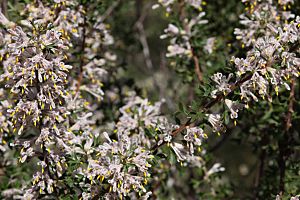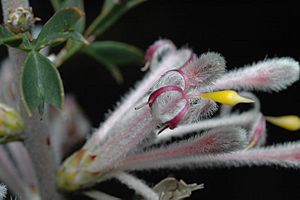Granite petrophile facts for kids
Quick facts for kids Granite petrophile |
|
|---|---|
 |
|
| In John Forrest National Park | |
| Scientific classification | |
| Genus: |
Petrophile
|
| Species: |
biloba
|
| Synonyms | |
|
|
The Petrophile biloba, also known as the granite petrophile, is a type of flowering plant. It belongs to the Proteaceae family, which includes many Australian native plants. This plant is endemic to southwestern Western Australia, meaning it naturally grows only in that area. It is a shrub with special leaves and pretty, hairy flowers.
Contents
What Does the Granite Petrophile Look Like?
The granite petrophile is a shrub that usually grows to be about 1 to 2 metres (3 to 7 feet) tall. Its young branches are hairy, but they become smooth as they get older.
Leaves and Stems
The leaves are quite unique. They are about 15 to 20 millimetres (0.6 to 0.8 inches) long. Each leaf sits on a stalk called a petiole, which can be up to 20 millimetres (0.8 inches) long. The leaves are deeply divided into two or three parts, almost down to the middle vein. Each part has a sharp, pointed tip.
Flowers and Fruit
The flowers grow in oval-shaped clusters, about 15 millimetres (0.6 inches) long. These clusters are found where the leaves meet the stem. Sometimes, they grow in groups. There are a few small leaves, called bracts, at the base of the flower clusters, but these often fall off.
The individual flowers are about 17 to 25 millimetres (0.7 to 1 inch) long. They are usually grey to pink and covered in fine hairs. You can see these flowers blooming from June to October. After flowering, the plant produces a type of fruit called a nut. These nuts are joined together in an oval-shaped head, about 10 to 14 millimetres (0.4 to 0.6 inches) long.
How Was This Plant Discovered and Named?
The Petrophile biloba was first officially described in 1830 by a famous botanist named Robert Brown. He wrote about it in a book called Supplementum to his larger work, Prodromus Florae Novae Hollandiae et Insulae Van Diemen.
The plant samples he studied were collected in 1827 by Charles Fraser. Fraser found them near the Swan River in Western Australia. The plant's specific name, biloba, comes from Latin. It means "two-lobed," which describes the plant's unique divided leaves.
Where Does the Granite Petrophile Grow?
This petrophile plant grows in a specific type of environment. It likes to grow in heath (a type of shrubland) over laterite, which is a reddish soil or rock. You can find it in southwestern Western Australia. Its range stretches from near the Canning River all the way to near Wannamal. It lives in areas known as the Jarrah Forest and the Swan Coastal Plain.
Is the Granite Petrophile Safe?
The Western Australian Government's Department of Parks and Wildlife keeps track of plant populations. They have classified Petrophile biloba as "not threatened." This means that, for now, there are enough of these plants in the wild, and they are not considered to be at risk of disappearing.


